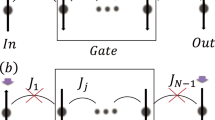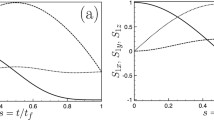Abstract
A continuous, sinusoidal control field is used to suitably transform quantum spin chains. In particular, we are able to transform the quantum Ising chain to the quantum XY model, and the XY model to the XYZ spin chain. Our applied control field can also mitigate the effect of noise on the spin chain. We show how these spin chain transformations can be useful for quantum state transfer as well as entanglement generation.
Graphic Abstract









Similar content being viewed by others
Data Availability Statement
This manuscript has no associated data in a data repository. [Authors’ comment: The datasets generated during and/or analysed during the current study are available from the corresponding author on reasonable request].
References
J.A. Kjäll, J.H. Bardarson, F. Pollmann, Many-body localization in a disordered quantum Ising chain. Phys. Rev. Lett. 113, 107204 (2014). https://doi.org/10.1103/PhysRevLett.113.107204
H. Li, J. Wang, X.-J. Liu, H. Hu, Many-body localization in Ising models with random long-range interactions. Phys. Rev. A 94, 063625 (2016). https://doi.org/10.1103/PhysRevA.94.063625
J. Šuntajs, J. Bonča, T. c. v. Prosen, L. Vidmar, Quantum chaos challenges many-body localization. Phys. Rev. E 102, 062144 (2020). https://doi.org/10.1103/PhysRevE.102.062144
R.H. McKenzie, Exact results for quantum phase transitions in random xy spin chains. Phys. Rev. Lett. 77, 4804 (1996). https://doi.org/10.1103/PhysRevLett.77.4804
D.S. Fisher, Critical behavior of random transverse-field Ising spin chains. Phys. Rev. B 51, 6411 (1995). https://doi.org/10.1103/PhysRevB.51.6411
T. Werlang, C. Trippe, G.A.P. Ribeiro, G. Rigolin, Quantum correlations in spin chains at finite temperatures and quantum phase transitions. Phys. Rev. Lett. 105, 095702 (2010). https://doi.org/10.1103/PhysRevLett.105.095702
J.K. Pachos, P.L. Knight, Quantum computation with a one-dimensional optical lattice. Phys. Rev. Lett. 91, 107902 (2003). https://doi.org/10.1103/PhysRevLett.91.107902
D. Porras, J.I. Cirac, Effective quantum spin systems with trapped ions. Phys. Rev. Lett. 92, 207901 (2004). https://doi.org/10.1103/PhysRevLett.92.207901
S. Haroche, J.M. Raimond, Exploring the Quantum: Atoms, Cavities, and Photons (Oxford University Press, Oxford, 2006)
Y.-M. Zhu, L. Ma, Entanglement distribution in star network based on spin chain in diamond. Phys. Lett. A 382, 1651 (2018). https://doi.org/10.1016/j.physleta.2018.04.028
Y. Ping, B.W. Lovett, S.C. Benjamin, E.M. Gauger, Practicality of spin chain wiring in diamond quantum technologies. Phys. Rev. Lett. 110, 100503 (2013). https://doi.org/10.1103/PhysRevLett.110.100503
M.C. Kuzyk, H. Wang, Scaling Phononic quantum networks of solid-state spins with closed mechanical subsystems. Phys. Rev. X 8, 041027 (2018). https://doi.org/10.1103/PhysRevX.8.041027
J.B. Parkinson, D.J.J. Farnell, Springer. An Introduction to Quantum Spin Systems (2010). https://doi.org/10.1007/978-3-642-13290-2
P. Cappellaro, C. Ramanathan, D.G. Cory, Simulations of information transport in spin chains. Phys. Rev. Lett. 99, 250506 (2007). https://doi.org/10.1103/PhysRevLett.99.250506
Z. Li, H. Zhou, C. Ju, H. Chen, W. Zheng, D. Lu, X. Rong, C. Duan, X. Peng, J. Du, Experimental realization of a compressed quantum simulation of a 32-spin Ising chain. Phys. Rev. Lett. 112, 220501 (2014). https://doi.org/10.1103/PhysRevLett.112.220501
X. Wang, A. Bayat, S.G. Schirmer, S. Bose, Robust entanglement in antiferromagnetic Heisenberg chains by single-spin optimal control. Phys. Rev. A 81, 032312 (2010). https://doi.org/10.1103/PhysRevA.81.032312
I. D’Amico, B.W. Lovett, T.P. Spiller, Freezing distributed entanglement in spin chains. Phys. Rev. A 76, 030302 (2007). https://doi.org/10.1103/PhysRevA.76.030302
V. Alba, F. Heidrich-Meisner, Entanglement spreading after a geometric quench in quantum spin chains. Phys. Rev. B 90, 075144 (2014). https://doi.org/10.1103/PhysRevB.90.075144
V. Subrahmanyam, A. Lakshminarayan, Transport of entanglement through a Heisenberg-xy spin chain. Phys. Lett. A 349, 164 (2006). https://doi.org/10.1016/j.physleta.2005.09.021
Z. Tian, P. Zhang, X.-W. Chen, Static hybrid quantum nodes: toward perfect state transfer on a photonic chip. Phys. Rev. Appl. 15, 054043 (2021). https://doi.org/10.1103/PhysRevApplied.15.054043
S. Singh, B. Adhikari, S. Dutta, D. Zueco, Perfect state transfer on hypercubes and its implementation using superconducting qubits. Phys. Rev. A 102, 062609 (2020). https://doi.org/10.1103/PhysRevA.102.062609
Y. Wang, F. Shuang, H. Rabitz, All possible coupling schemes in \(\mathit{XY}\) spin chains for perfect state transfer. Phys. Rev. A 84, 012307 (2011). https://doi.org/10.1103/PhysRevA.84.012307
A. Kay, Perfect state transfer: beyond nearest-neighbor couplings. Phys. Rev. A 73, 032306 (2006). https://doi.org/10.1103/PhysRevA.73.032306
G.A. Álvarez, M. Mishkovsky, E.P. Danieli, P.R. Levstein, H.M. Pastawski, L. Frydman, Perfect state transfers by selective quantum interferences within complex spin networks. Phys. Rev. A 81, 060302 (2010). https://doi.org/10.1103/PhysRevA.81.060302
A. Bayat, Arbitrary perfect state transfer in \(d\)-level spin chains. Phys. Rev. A 89, 062302 (2014). https://doi.org/10.1103/PhysRevA.89.062302
G. Gualdi, V. Kostak, I. Marzoli, P. Tombesi, Perfect state transfer in long-range interacting spin chains. Phys. Rev. A 78, 022325 (2008). https://doi.org/10.1103/PhysRevA.78.022325
M. Christandl, N. Datta, A. Ekert, A.J. Landahl, Perfect state transfer in quantum spin networks. Phys. Rev. Lett. 92, 187902 (2004). https://doi.org/10.1103/PhysRevLett.92.187902
D. Bazhanov, I. Sivkov, V. Stepanyuk, Engineering of entanglement and spin state transfer via quantum chains of atomic spins at large separations. Sci. Rep. 8, 14118 (2018). https://doi.org/10.1038/s41598-018-32145-3
G. Sadiek, B. Alkurtass, O. Aldossary, Entanglement in a time-dependent coupled \(\mathit{XY}\) spin chain in an external magnetic field. Phys. Rev. A 82, 052337 (2010). https://doi.org/10.1103/PhysRevA.82.052337
J. Cui, F. Mintert, Robust control of long-distance entanglement in disordered spin chains. New J. Phys. 17, 093014 (2015). https://doi.org/10.1088/1367-2630/17/9/093014
X. Zhang, B. Shao, J. Zou, Optimal control for fast and robust generation of entangled states in anisotropic Heisenberg chains. Int. J. Theor. Phys. (2017). https://doi.org/10.1007/s10773-017-3301-2
S. Austin, M.Q. Khan, M. Mudassar, A.Z. Chaudhry, Continuous dynamical decoupling of spin chains: modulating the spin-environment and spin-spin interactions. Phys. Rev. A 100, 022102 (2019). https://doi.org/10.1103/PhysRevA.100.022102
M. Kargarian, R. Jafari, A. Langari, Dzyaloshinskii–Moriya interaction and anisotropy effects on the entanglement of the Heisenberg model. Phys. Rev. A 79, 042319 (2009). https://doi.org/10.1103/PhysRevA.79.042319
R. Jafari, M. Kargarian, A. Langari, M. Siahatgar, Phase diagram and entanglement of the Ising model with Dzyaloshinskii-Moriya interaction. Phys. Rev. B 78, 214414 (2008). https://doi.org/10.1103/PhysRevB.78.214414
E. Mehran, S. Mahdavifar, R. Jafari, Induced effects of the Dzyaloshinskii–Moriya interaction on the thermal entanglement in spin-1/2 Heisenberg chains. Phys. Rev. A 89, 042306 (2014). https://doi.org/10.1103/PhysRevA.89.042306
A. Irfan, S. F. A. Hashmi, S. N. Zaidi, M. U. Baig, and A. Z. Chaudhry, Continuous dynamical decoupling of spin chains: inducing two-qubit interactions to generate perfect entanglement ( 2020). arXiv:2012.03873 [quant-ph]
A.Z. Chaudhry, J. Gong, Decoherence control: universal protection of two-qubit states and two-qubit gates using continuous driving fields. Phys. Rev. A 85, 012315 (2012). https://doi.org/10.1103/PhysRevA.85.012315
L. Viola, E. Knill, S. Lloyd, Dynamical decoupling of open quantum systems. Phys. Rev. Lett. 82, 2417 (1999). https://doi.org/10.1103/PhysRevLett.82.2417
F. F. Fanchini, R. d. J. Napolitano, Continuous dynamical protection of two-qubit entanglement from uncorrelated dephasing, bit flipping, and dissipation. Phys. Rev. A 76, 062306 (2007). https://doi.org/10.1103/PhysRevA.76.062306
A.Z. Chaudhry, J. Gong, Amplification and suppression of system-bath-correlation effects in an open many-body system. Phys. Rev. A 87, 012129 (2013). https://doi.org/10.1103/PhysRevA.87.012129
F. F. Fanchini, J. E. M. Hornos, R. d. J. Napolitano, Continuously decoupling single-qubit operations from a perturbing thermal bath of scalar bosons. Phys. Rev. A 75, 022329 (2007). https://doi.org/10.1103/PhysRevA.75.022329
A.Z. Chaudhry, J. Gong, Protecting and enhancing spin squeezing via continuous dynamical decoupling. Phys. Rev. A 86, 012311 (2012). https://doi.org/10.1103/PhysRevA.86.012311
W. Huang, Y.-L. Zhang, C.-L. Zou, X.-B. Zou, G.-C. Guo, Two-axis spin squeezing of two-component Bose-Einstein condensates via continuous driving. Phys. Rev. A 91, 043642 (2015). https://doi.org/10.1103/PhysRevA.91.043642
M. Abramowitz, I.A. Stegun, Handbook of Mathematical Functions (Dover Publications, Mineola, 1972)
K. Jacobs, Stochastic Processes for Physicists: Understanding Noisy Systems (Cambridge University Press, Cambridge, 2010). https://doi.org/10.1017/CBO9780511815980
K.R.K. Rao, T.S. Mahesh, A. Kumar, Efficient simulation of unitary operators by combining two numerical algorithms: An NMR simulation of the mirror-inversion propagator of an \(xy\) spin chain. Phys. Rev. A 90, 012306 (2014). https://doi.org/10.1103/PhysRevA.90.012306
Z.-H. Wang, W. Zhang, A.M. Tyryshkin, S.A. Lyon, J.W. Ager, E.E. Haller, V.V. Dobrovitski, Effect of pulse error accumulation on dynamical decoupling of the electron spins of phosphorus donors in silicon. Phys. Rev. B 85, 085206 (2012). https://doi.org/10.1103/PhysRevB.85.085206
Y.C. Liu, Z.F. Xu, G.R. Jin, L. You, Spin squeezing: Transforming one-axis twisting into two-axis twisting. Phys. Rev. Lett. 107, 013601 (2011). https://doi.org/10.1103/PhysRevLett.107.013601
C. Shen, L.-M. Duan, Efficient spin squeezing with optimized pulse sequences. Phys. Rev. A 87, 051801 (2013). https://doi.org/10.1103/PhysRevA.87.051801
M.H. Schleier-Smith, I.D. Leroux, V. Vuletić, Squeezing the collective spin of a dilute atomic ensemble by cavity feedback. Phys. Rev. A 81, 021804 (2010). https://doi.org/10.1103/PhysRevA.81.021804
I.D. Leroux, M.H. Schleier-Smith, V. Vuletić, Implementation of cavity squeezing of a collective atomic spin. Phys. Rev. Lett. 104, 073602 (2010). https://doi.org/10.1103/PhysRevLett.104.073602
D. Wanish, S. Fritzsche, Driven spin chains as high-quality quantum routers. Phys. Rev. A 102, 032624 (2020). https://doi.org/10.1103/PhysRevA.102.032624
Author information
Authors and Affiliations
Contributions
AZC came up with the basic idea behind this work. HS carried out the calculations and plotted the graphs. Both authors contributed towards the writing of the manuscript.
Corresponding author
Rights and permissions
Springer Nature or its licensor holds exclusive rights to this article under a publishing agreement with the author(s) or other rightsholder(s); author self-archiving of the accepted manuscript version of this article is solely governed by the terms of such publishing agreement and applicable law.
About this article
Cite this article
Soomro, H., Chaudhry, A.Z. Spin chain transformations under continuous driving fields. Eur. Phys. J. D 76, 180 (2022). https://doi.org/10.1140/epjd/s10053-022-00509-0
Received:
Accepted:
Published:
DOI: https://doi.org/10.1140/epjd/s10053-022-00509-0




